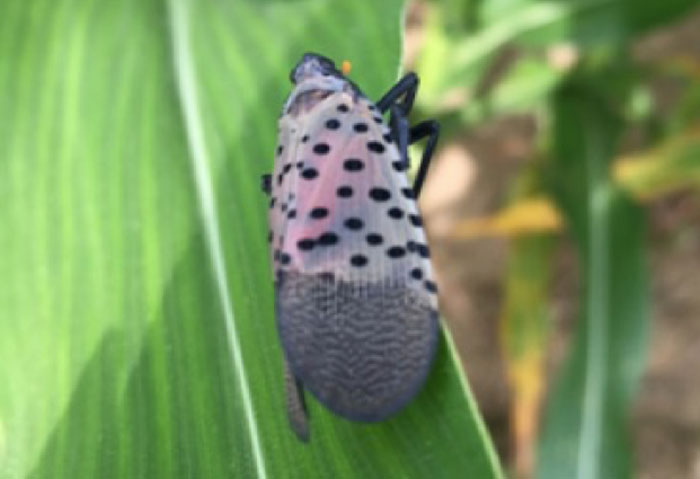Taking an environmentally sensitive approach to pest management
Spotted Lanternfly: An Invasive Pest with a Wide Host Range
Published: June 28, 2018
The spotted lanternfly (Lycorma delicatula) is an exotic pest that feeds on more than 70 woody plant species, including, blueberries, lilac, birch, maple, poplar, Virginia creeper, forest trees, etc. Nymphs apparently feed on a wide range of hosts, but adults prefer specific hosts, such as apple, stone fruit, grapes, black walnut, and tree of heaven (Ailanthus altissima). Large populations of egg-laying adults congregate on tree trunks to suck plant sap from the phloem. Symptoms of spotted lanternfly feeding are sap oozing on a trunk, wilting of foliage, branch dieback, and in severe cases, mortality of young trees and vines. This insect also secretes honeydew (sticky, sugary substance) on which sooty blotch grows. Sooty blotch, caused by several fungal pathogens, also develops on bleeding sap and blackens plant tissue. On tree of heaven, black streaks of sooty mold may be visible on tree trunks or mats of fungal growth at the base of trees. Although sooty mold is superficial, discolored fruit is unmarketable.
Spotted lanternfly is native to northern China, but is also found in Taiwan, Viet Nam, Japan, and South Korea. From there it was introduced into southeastern Pennsylvania in 2014 and spread to Virginia, New York, and Delaware by 2018. Although spotted lanternfly has not yet been reported in Missouri, it may only be a matter of time. Females lay their eggs on tree bark, rocks, metal and wood posts, outdoor equipment, vehicles, shipping containers, or any hard surface. Because the spotted lanternfly is actually a leafhopper, only adults have a limited ability to fly great distances. Thus, this insect is generally spread to new sites when egg cases are transported on objects to another location.
There is only one generation per year of spotted lanternfly. In Pennsylvania, overwintering eggs hatch in May. The first three instars (immature nymphs) have a black body with white spots and are about 3.6 to 9.4 mm-long. These instars can be mistaken for ticks, however, lanternfly crawlers jump whereas ticks do not. The fourth instar has a red body with white spots and is 6.9 to 9.4 mm-long. Nymphs crawl up trees after they emerge and fall off when they meet an obstacle or are wind-blown, but resume their ascent up the plant.

Figure 1 Adult spotted lanternfly with folded gray-spotted forewings. Photo credit: Pennsylvania Department of Agriculture

Figure 2 Adult spotted lanternfly with red hind wings visible. Photo credit: Penn State Extension
Adults are easily mistaken for moths in the fall. Spotted lanternfly adults range from 20 to 27 mm-long and when congregated on tree trunks, their gray forewings with distinctive black spots and wing tips with reticulated black and gray blocks are visible (Figure 1). When extended, red hind wings of the insect can be seen (Figure 2). In the fall, adults congregate on trunks or sometimes on warm surfaces of buildings. Unlike Asian lady beetles, spotted lanternflies do not seek indoor shelter. Also, lanternflies do not bite humans, but contain cantharidin which can cause blistering on humans and animals. Ants and stinging insects, such as bees, hornets, wasps, and yellow jackets, collect excreted honeydew and may cause injury to humans. Natural enemies of the spotted lanternfly include spiders, praying mantis, and assassin bugs.
Females lay 30 to 50 eggs aligned in rows. Egg masses are covered in a waxy substance which dries, cracks, and may look like a splash of mud. An individual female can lay at least two egg masses per growing season. Thus far, spotted lanternfly egg masses have survived cold temperature exposure in North American sites, but failed to hatch in colder regions of South Korea.
To manage the spotted lanternfly, a quarantine of susceptible plant host has been imposed in Pennsylvania. Egg masses are scraped from objects, placed in alcohol or hand sanitizer to kill them or sealed with two bags for disposal. Brown-colored sticky bands placed around the base of susceptible trees are used to collect nymphs, whereas blue or yellow bands are less effective. The Pennsylvania Department of Agriculture lists insecticides label for use in home landscapes and gardens at: http://www.agriculture.pa.gov/Plants_Land_Water/PlantIndustry/Entomology/spotted_lanternfly/Documents/SLF%20Control%209-13-2017.pdf. In some situations, Ailanthus trees are removed or killed with a systemic herbicide. Alternatively, an attract and kill strategy is used, whereby Ailanthus trees attract lanternflies, but insects are killed after feeding on trunks treated with a systemic insecticide such as dinotefuran. Lanternflies are susceptible to several insecticides commonly used in commercial orchards and vineyards, including products such as Actara, Assail, Sevin, Malathion, and Imidan. Application of neem oil or insecticidal soap to trees produced variable results and required several days to determine the effect of the spray.
If you have a tree of heaven growing on your property, inspect the trunk routinely in the summer for spotted lanternfly crawlers and in the fall for adults that tend to aggregate. These trees are usually medium-sized with a spreading form and their compound leaves have 11 to 42 leaflets. A complete description and images of tree of heaven, as well as species similar in appearance, can be found at: https://nature.mdc.mo.gov/discover-nature/field-guide/tree-heaven.
If you find a lanternfly at any life stage, please do not destroy it. Collect specimens in a sealed container and submit it to your local Extension office. Also record precisely where the specimen was found and include GPS coordinates if possible. Exercise caution when collecting a specimen as sap from tree of heaven can cause headaches, nausea, and heart problems for some individuals.
Subscribe to receive similar articles sent directly to your inbox!
REVISED: March 1, 2021